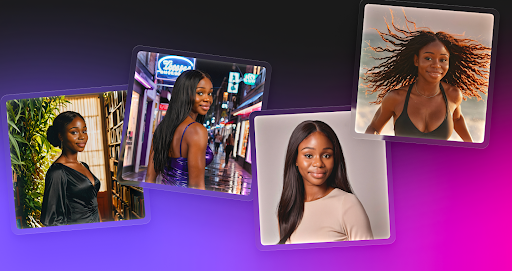Rethinking Image Variation with AI Face Swaps

Outcome first
Open a photo. Pick the face to replace. Supply a different face. The new image keeps pose, light, and camera geometry. Identity changes. Composition stays. It runs in a browser and on iOS. No installers. No drivers. Anyone on the team can try a version during a review and ship a decision the same hour.
The system detects several faces in one frame. You can change one subject or many in a single pass. Batch processing repeats one donor across a folder of targets so a character reads as the same person across banners, decks, tutorials, and store listings. A curated donor gallery speeds the hunt for matching angle and light. Account history lets you recover earlier outputs when direction pivots.
Where it sits in the pipeline
Designers place it between first art direction and the reshoot call. Illustrators use a swapped frame as structure so proportions stay honest across a series. Marketers localize heroes for regions or cohorts and run true splits where persona is the only variable. Content managers anonymize real people while keeping scenes intact. Photographers deliver credible alternates when talent is not available. App teams wrap the browser flow in a small internal utility that turns folders of inputs into approved outputs on a schedule. This is production gear.
How results hold up when you zoom in
With clean inputs, outputs survive common delivery sizes for web, stores, and slide decks. Moderate head turns behave. Even frontal light behaves. Groups of two to four people are practical. Artifacts repeat in familiar places. Hairlines sometimes need a quick tidy. Thin glasses frames can fringe. Strong backlight and heavy makeup can reveal an edge. Motion blur and extreme angles lower credibility. Match donor and target for pose and key light and the success rate climbs fast.
Across a fourteen image bench that mirrored a real mix of studio, environmental, and phone shots we kept five outputs as is. Seven needed under two minutes each to tidy hair or glasses. Two were rejected for motion blur and a severe angle. Plan for that pattern and you stay on time.
Hands on check while you read
If you want evidence from your own files, run a short test on faceswap. Use a head and shoulders photo with even light and a neutral angle for both donor and target. Skip heavy compression for the first pass. You will know within a minute whether the baseline clears your bar.
What helps and what hurts
Helps
- Match head angle within about ten degrees and keep the main light within about one stop between donor and target.
- Start from the cleanest version of the file. Compression hides detail that blending needs.
- Keep early backgrounds simple. Busy texture makes seams easy to spot.
- Normalize exposure and white balance for batches before you swap. Consistency up front saves retouch time.
Hurts
- Very oblique head turns.
- Motion blur.
- Occlusions from hands and heavy hair across the face.
- Harsh backlights and glitter level makeup.
Role based guidance you can act on
Designers use swaps to answer the only question that matters. Does the concept read better with a different persona. Prepare two or three variants inside the same layout. Keep type and color locked. Change only the face. Pick the strongest read and move on.
Illustrators treat the swap like scaffolding. The frame gives bone structure and alignment. Draw over it. Hide the layer. Form stays consistent across a set and you spend energy on line and style.
Design students build a five target study set. Studio portrait. Environmental portrait. Group photo. Stock image. Phone selfie. Pick three donors that differ by age and skin tone. Swap across combinations. Review at full zoom for edges and color, then at normal size for plausibility. Write down what fails and why. That lesson sticks.
Marketers and content managers localize a hero in minutes and run a clean split. Keep copy and layout identical. Change only persona. Measure click through or completion. For help content, swap the face and keep the workflow visible so the scene stays honest.
Business owners and leads ask for a swapped comp before greenlighting a reshoot. Weak ideas fall earlier. Budget stays with the strong direction.
Photographers keep projects moving when talent cannot return. Deliver two or three credible alternates. When the client picks a direction, finish with your standard retouch pass. The tool does not replace light and expression. It buys you speed.
App developers connect the service to a simple internal tool. Accept a folder of targets, one donor, and an approval checklist. Validate minimum resolution and acceptable angle at intake. Store outputs with access logs. Insert a single human accept or reject step. Quality stays stable without building your own vision stack.
General users follow two rules. Use photos you have the right to edit. Disclose edits where identity matters. Clear rights and clear context prevent most problems.
Privacy and governance that survive handoffs
Uploaded images are processed to produce results. Account controls allow clearing history. The iOS path uploads for processing and returns results to the device. Treat these defaults as a solid baseline. In a regulated setting add a retention rule and access logging. Insert a short approval step before publication. Map the policy to a common framework so it survives personnel changes and audits.
A bench that reflects real work
Mirror what you actually ship. Five targets are enough to learn the limits. Include studio, environmental, group, stock, and a phone selfie. Select three donors with different ages and skin tones. Swap across combinations. Record what needed cleanup and how long. Set a publication threshold. Allow three minutes of retouch per published image and none for internal comps. Keep a short log of rejects and reasons. Patterns will surface and inputs will improve.
Verdict with a spine
Faceswap does one job and does it well. It speeds decisions. It keeps comps believable. It often ships after a short tidy. Prepare inputs with care and you save hours and avoid reshoots. That is the metric that matters in production.





